Optimization of Load Rejection Regulation for Compressed Air Energy Storage
Abstract
1. Introduction
2. Model Establishment
2.1. Mathematic Model
2.1.1. Gas Storage Tank
2.1.2. Expander
2.1.3. Shaft
2.1.4. Heat Exchanger
2.2. Modeling Idea and Verification
2.2.1. Speed Control Model
2.2.2. Power Network Model
2.2.3. Power Control Model
2.2.4. Temperature Control Model of Expander Inlet
2.2.5. Load Rejection Control Model
3. Mechanism Analysis
3.1. Decoupling Guard Against the Overspeed Stage
3.2. System Recovery Standby Phase
3.3. Strategy Analysis
4. Conclusions
- (1)
- The influence of load rejection action from all levels of the cut-off valve on rotor speed after decoupling between the system and load under different working conditions is analyzed, and it is concluded that the residual working fluid is the key to speed control. For a multi-stage expansion CAES system, the only speed control valve (SCV) is limited, so the speed surge can be well prevented by closing the load rejection action of the front-end cut-off valves for all expander levels;
- (2)
- After the operation of the cut-off valve, the speed is quickly controlled, but through analysis of the main factors affecting speed control in the system, after the expander is cut off, high-temperature and high-pressure air will be left in the pipes and heat exchangers in the system, which will cause the speed of the generator to soar again, so it is necessary to discharge the residual working fluid;
- (3)
- Aiming at the key factors of load rejection control of CAES, a new control strategy is proposed; through the action of the cut-off valve between the stages of expanders, the rotational speed is steadily reduced to less than 3000 r/min, and the residual working fluid is discharged. The results show that under a 100% load condition, the speed increment of the optimized load rejection strategy is reduced by 89% compared to the traditional strategy, and the recovery standby practice is reduced by 65%. Compared with the traditional strategy, the speed increment of the optimized load rejection strategy is reduced by 87% and the recovery standby practice is reduced by 41%. Under 50% load conditions, the speed increment of the optimized load rejection strategy is reduced by 86%, and the recovery standby time is reduced by 33%. The speed control effect of the optimized load rejection strategy is much better than that of the traditional strategy.
Author Contributions
Funding
Data Availability Statement
Conflicts of Interest
References
- Razmi, A.R.; Soltani, M.; Ardehali, A.; Gharali, K.; Dusseault, M.; Nathwani, J. Design, thermodynamic, and wind assessments of a compressed air energy storage (CAES) integrated with two adjacent wind farms: A case study at Abhar and Kahak sites, Iran. Energy 2021, 221, 119902. [Google Scholar] [CrossRef]
- Liu, X.C.; Mei, S.W.; Ding, R.C.; Zhong, S.Y.; Zhang, J.F.; Xie, N.N.; Chang, Y.; Zhang, T. Present situation, Development trend and Application Prospect of compressed Air Energy Storage Engineering. Electr. Power Autom. Equip. 2023, 43, 38–47+102. [Google Scholar] [CrossRef]
- Lai, D.H.; Luo, W.F.; Huang, J.H. Power adaptive control of hybrid energy storage multi-microgrid based on edge calculation. Big Data Electr. Power 2023, 26, 28–35. [Google Scholar] [CrossRef]
- Aquilina, L.; Sant, T.; Farrugia, R.N.; Licari, J.; Spiteri Staines, C.; Buhagiar, D. Measurements and Modelling of the Discharge Cycle of a Grid-Connected Hydro-Pneumatic Energy Storage System. Energies 2024, 17, 1597. [Google Scholar] [CrossRef]
- Yang, D.H.; Wen, X.K.; Zhong, J.L.; Feng, T.; Deng, T.T.; Li, X. Compressed Air Energy Storage System with Burner and Ejector. Energies 2023, 16, 537. [Google Scholar] [CrossRef]
- Cheng, Z.W. Off-Condition Performance Analysis and Design Optimization of Low Temperature Adiabatic Compressed Air Energy Storage System. Ph.D. Thesis, Zhejiang University, Hangzhou, China, 2019. [Google Scholar]
- Li, P.; Yang, C.; Sun, L.; Xiang, J.; Wen, X.; Zhong, J.; Deng, T. Dynamic characteristics and operation strategy of the discharge process in compressed air energy storage systems for applications in power systems. Int. J. Energy Res. 2020, 44, 6363–6382. [Google Scholar] [CrossRef]
- Wen, X.K.; Zhang, H.F.; Yang, D.H.; Zhong, J.L.; Feng, T.Y. Compressed air energy storage participates in the research of primary frequency regulation of power grid in both directions. Autom. Instrum. 2021, 42, 67–70+76. [Google Scholar] [CrossRef]
- Kamyar, R.; Ehsan, S.; Roydon, A.F. A comprehensive data-driven study of electrical power grid and its implications for the design, performance, and operational requirements of adiabatic compressed air energy storage systems. Appl. Energy 2020, 257, 113990. [Google Scholar]
- Meng, J.H.; Sun, Y.X.; Zhang, Z.L.; Wang, C.Y. Compressed Air Energy Storage Linear Auto-Disturbance Rejection Smooth Grid-Connected Control Strategy with Adaptive Bandwidth Parameters. J. Power Supply 2024, 1–17. Available online: http://kns.cnki.net/kcms/detail/12.1420.tm.20240725.0916.002.html (accessed on 1 November 2024).
- Sheng, W.; Xu, Z. Research on load rejection protection of PWR power plants at different power levels. In Proceedings of the 2019 IEEE Innovative Smart Grid Technologies—Asia (ISGT Asia), Chengdu, China, 21–24 May 2019; pp. 525–530. [Google Scholar] [CrossRef]
- Ban, G.B.; Ma, X.H.; Ouyang, Z.Y.; Yu, Y.X.; Yuan, X.F.; Liu, L. Research on peak-cutting and valley-filling strategy considering flexible access of energy storage system. Power Syst. Big Data 2021, 24, 1–8. [Google Scholar] [CrossRef]
- Zhang, X.; Chen, L.J.; Cui, S.; Liu, H.C.; Mei, S.W. Analysis of operational feasible region of advanced adiabatic compressed air energy storage system under wide operating conditions. Grid Technol. 2024, 1–10. [Google Scholar] [CrossRef]
- Wang, J.H.; Zhao, J.; Zhong, J.L.; Wang, S.B.; Xu, Z.F. Cause analysis and treatment of overspeed in load rejection test of supercritical unit. Therm. Power Gener. 2018, 47, 115–119. [Google Scholar] [CrossRef]
- Xu, G.Z.; Liang, L.X.; Lu, C.; Cui, S.S.; Bai, Z.W.; Song, J.; Deng, Z.F.; He, Q. Study on speed rise characteristics of expander rotor during load rejection of liquefied air energy storage system. Therm. Power Gener. 2020, 49, 72–79. [Google Scholar] [CrossRef]
- Wen, X.K.; Zhong, J.L.; Deng, T.T.; Li, Q.M. Method to Calculate Maximum Speed of Turbine Expander of 10MW CAES after Load Rejection. In Proceedings of the 2019 IEEE International Conference on Power, Intelligent Computing and Systems (ICPICS), Shenyang, China, 12–14 July 2019; pp. 576–578. [Google Scholar] [CrossRef]
- Yang, C.; Li, P.; Sun, L.; Chai, J. Strategy of load rejection and overspeed prevention of compressed air energy storage expansion generator. J. Sol. Energy 2021, 42, 449–454. [Google Scholar]
- Eveliina, T. Modeling of Pressurizer Using Apros and Trace Thermal Hydraulic Codes. Master’s Thesis, Lappeenranta University of Technology, Lappeenranta, Finland, 2006. [Google Scholar]
- Li, P. Study on Dynamic Characteristics and Operation Strategy of Energy Release Process of Compressed Air Energy Storage System. Master’s Thesis, Chongqing University, Chongqing, China, 2020. [Google Scholar]
- Wang, D.J.; Sun, Y.X.; Ge, Y.M.; Li, J.; Yan, C.Y.; Meng, J.H. A smooth grid connection strategy for compressed air energy storage based on adaptive PI control. Front. Energy Res. 2024, 12, 1344749. [Google Scholar] [CrossRef]
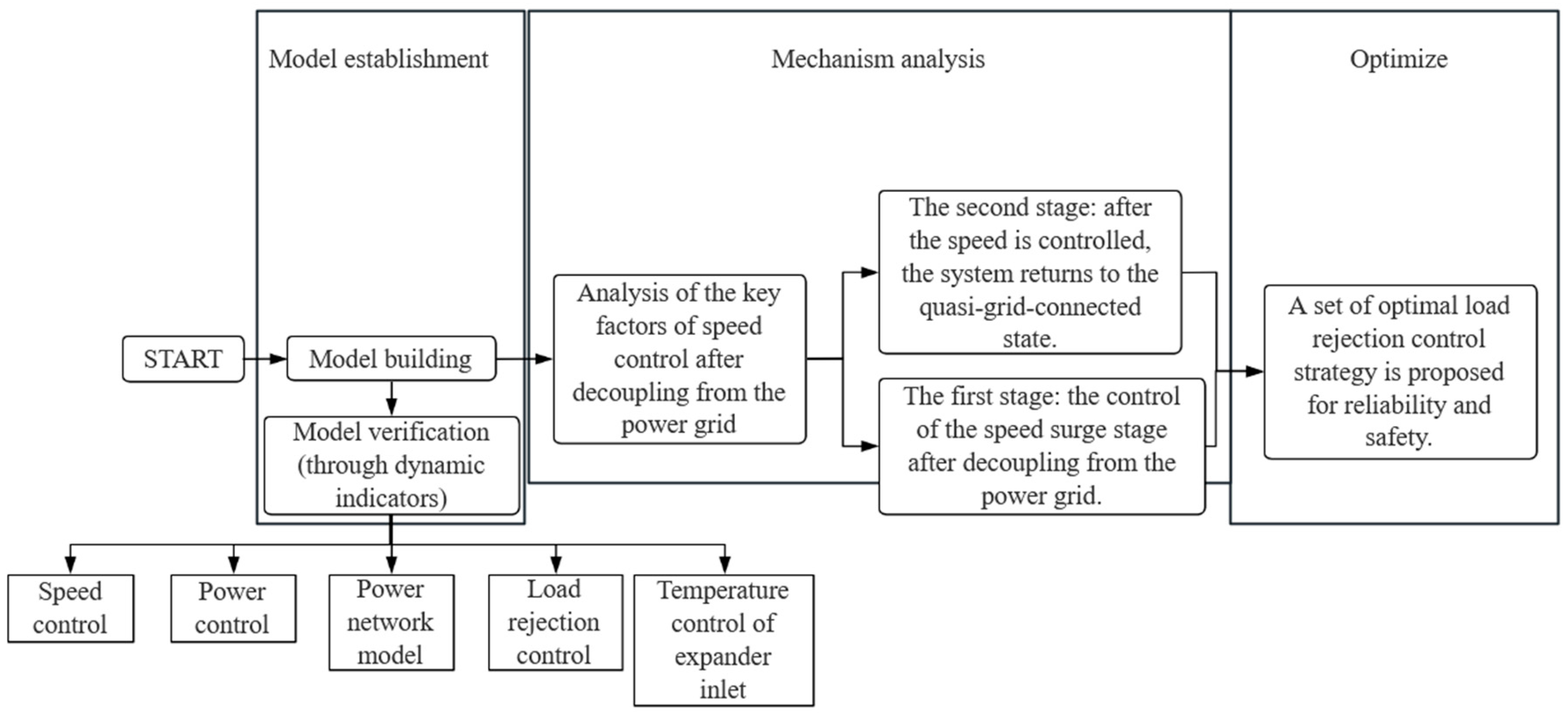
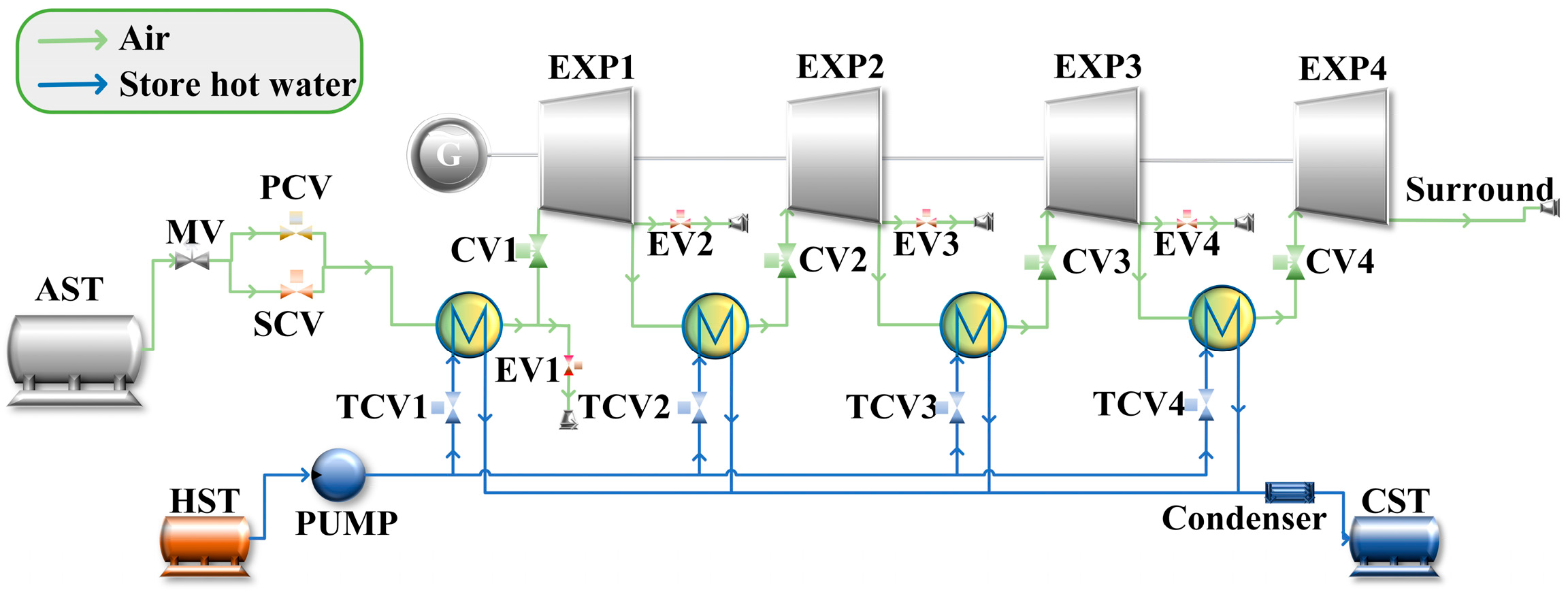

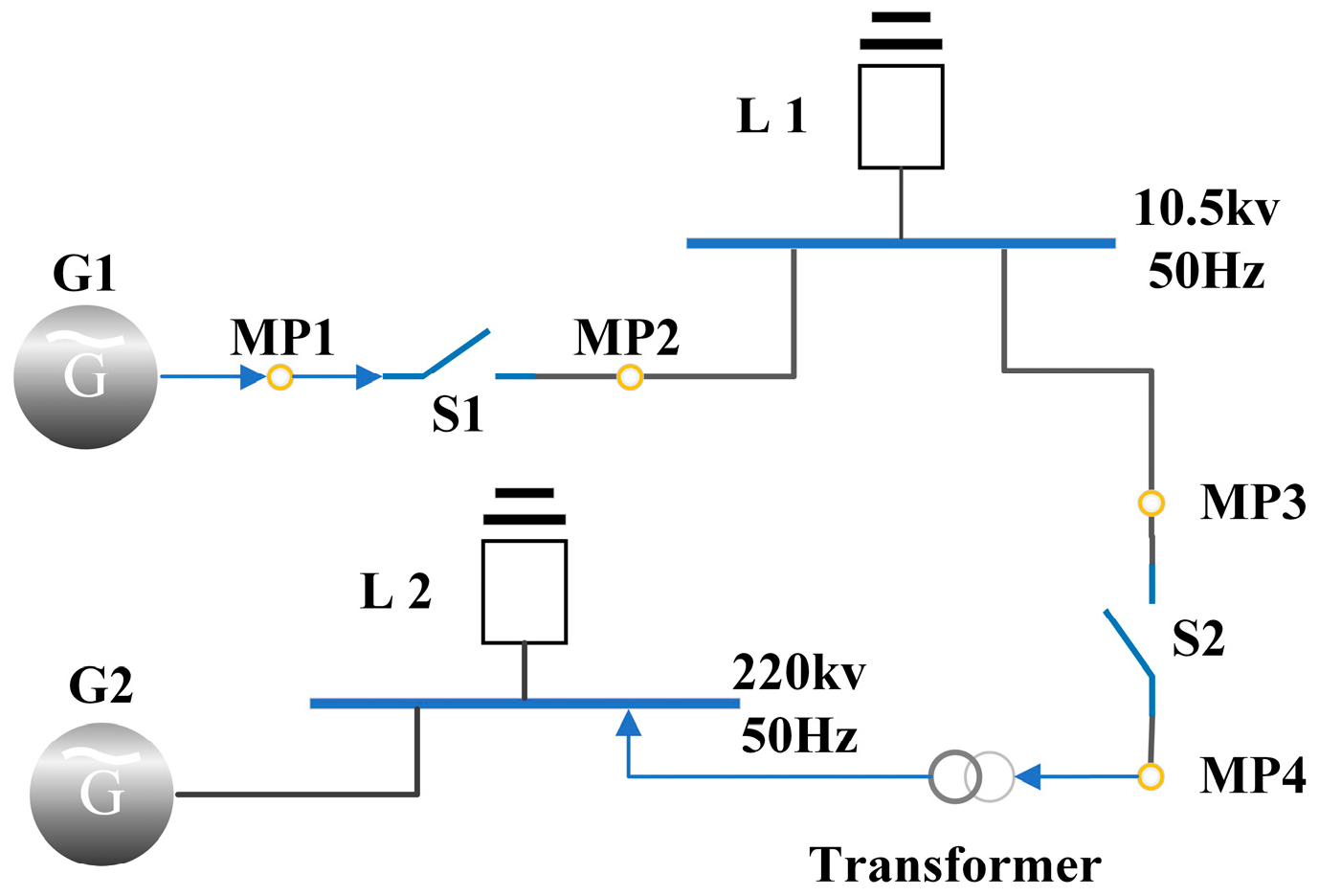

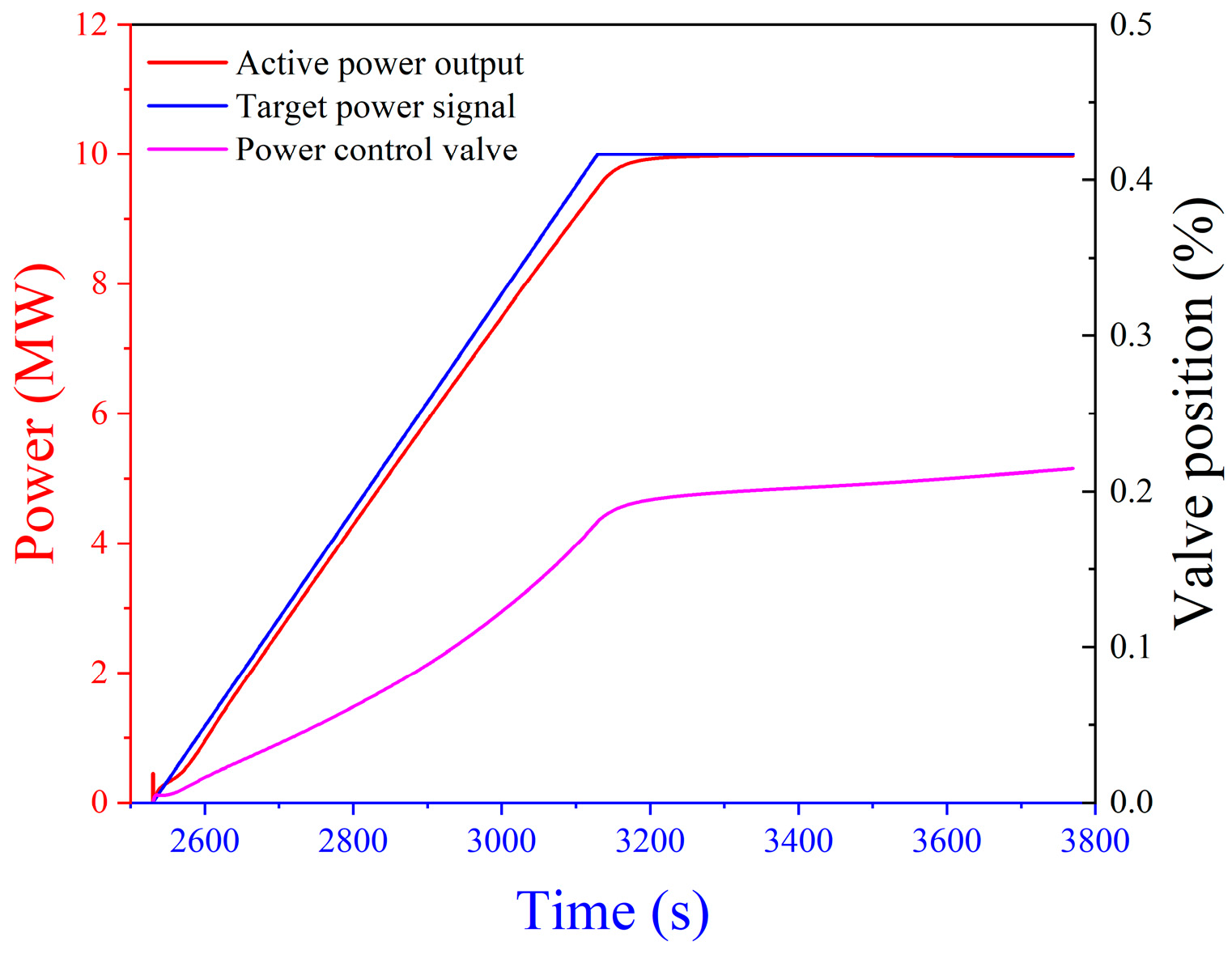
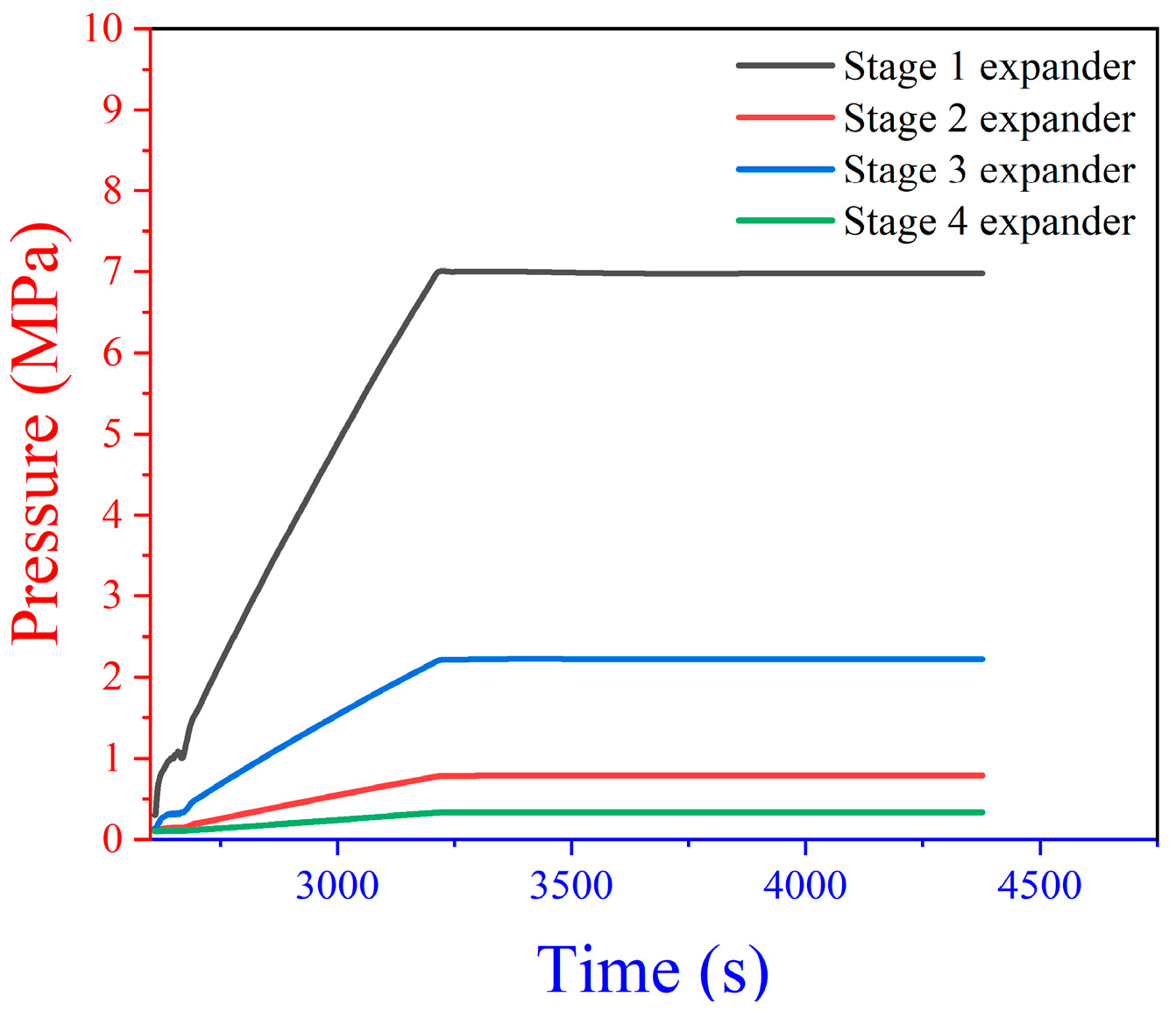





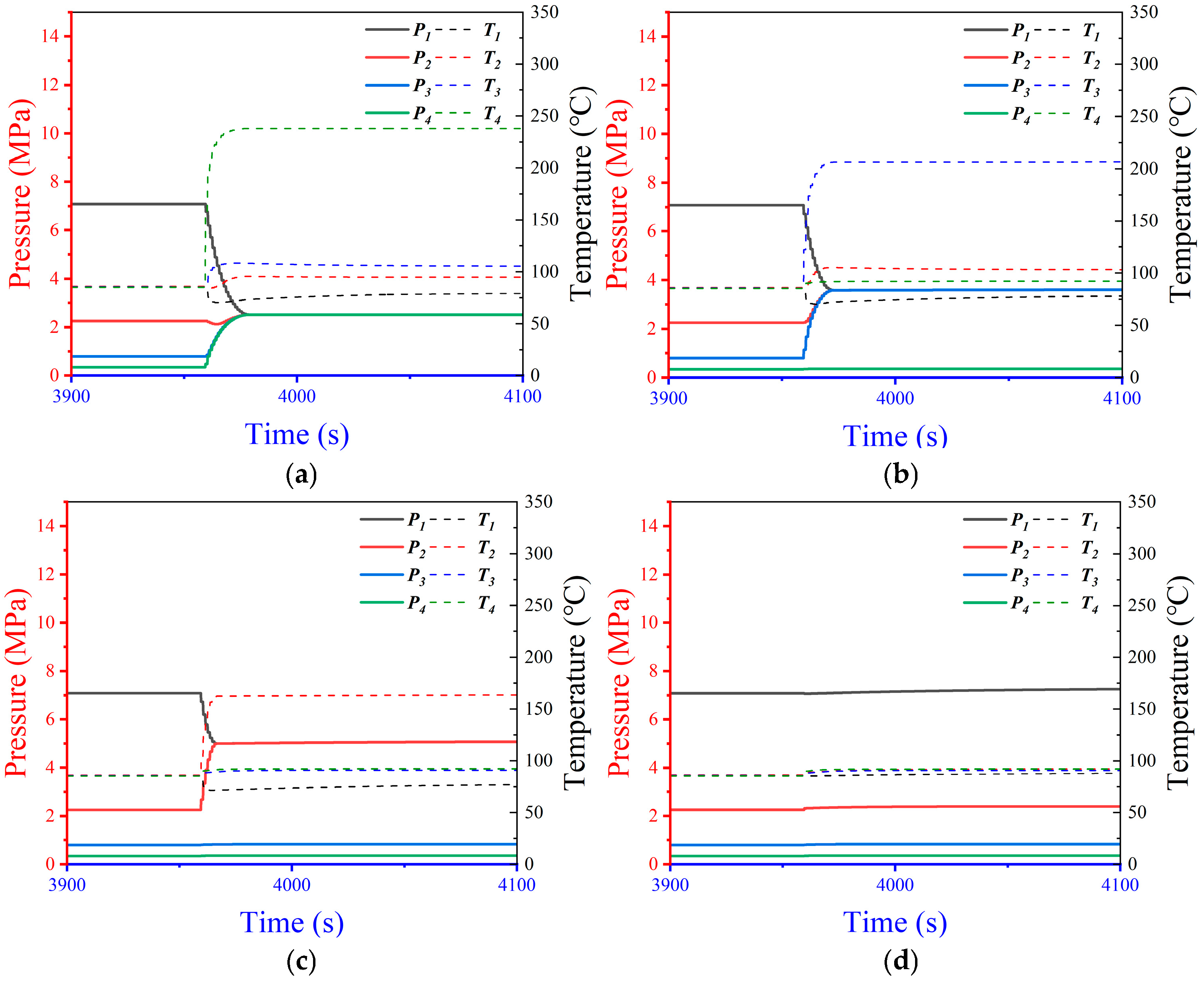
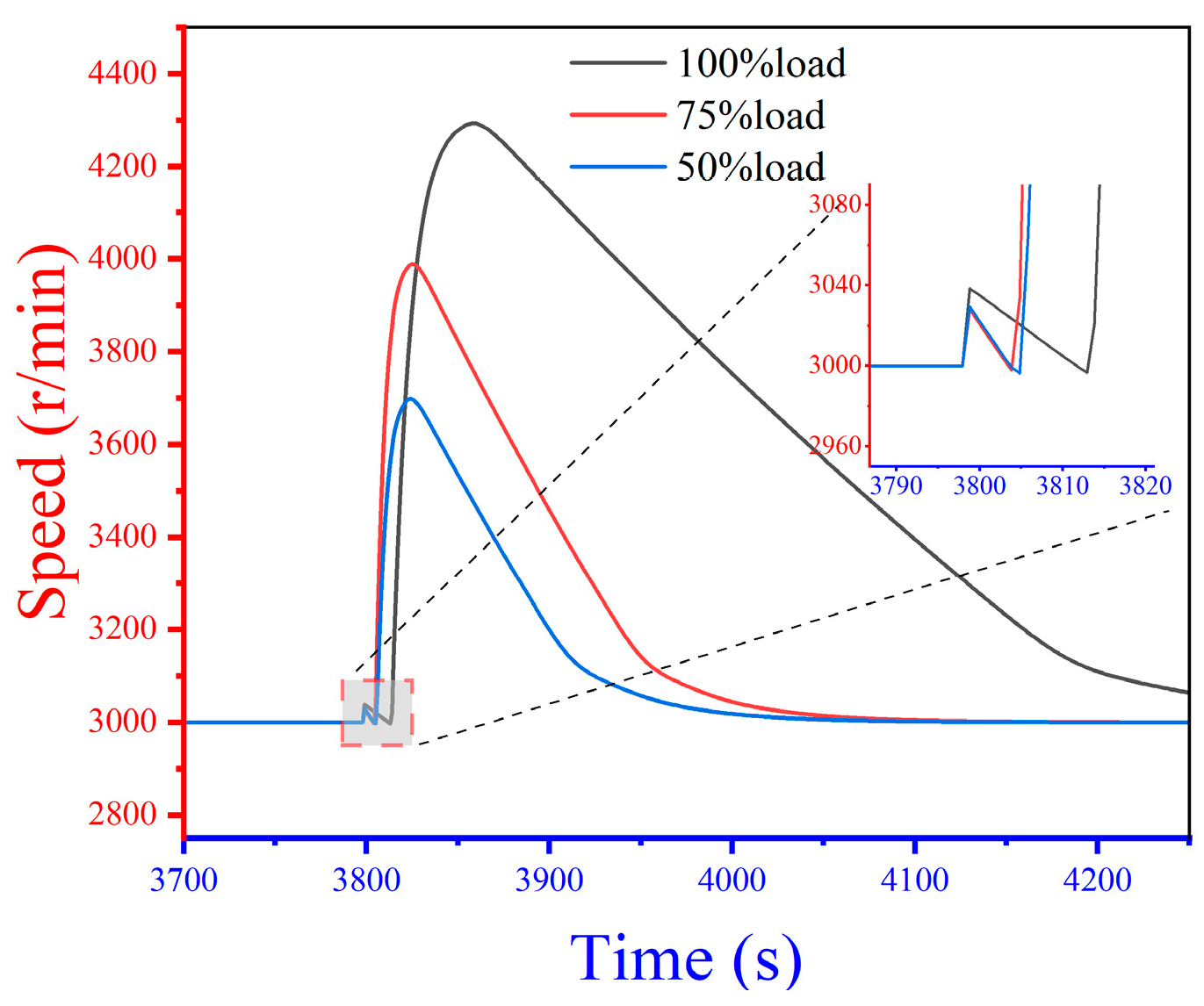

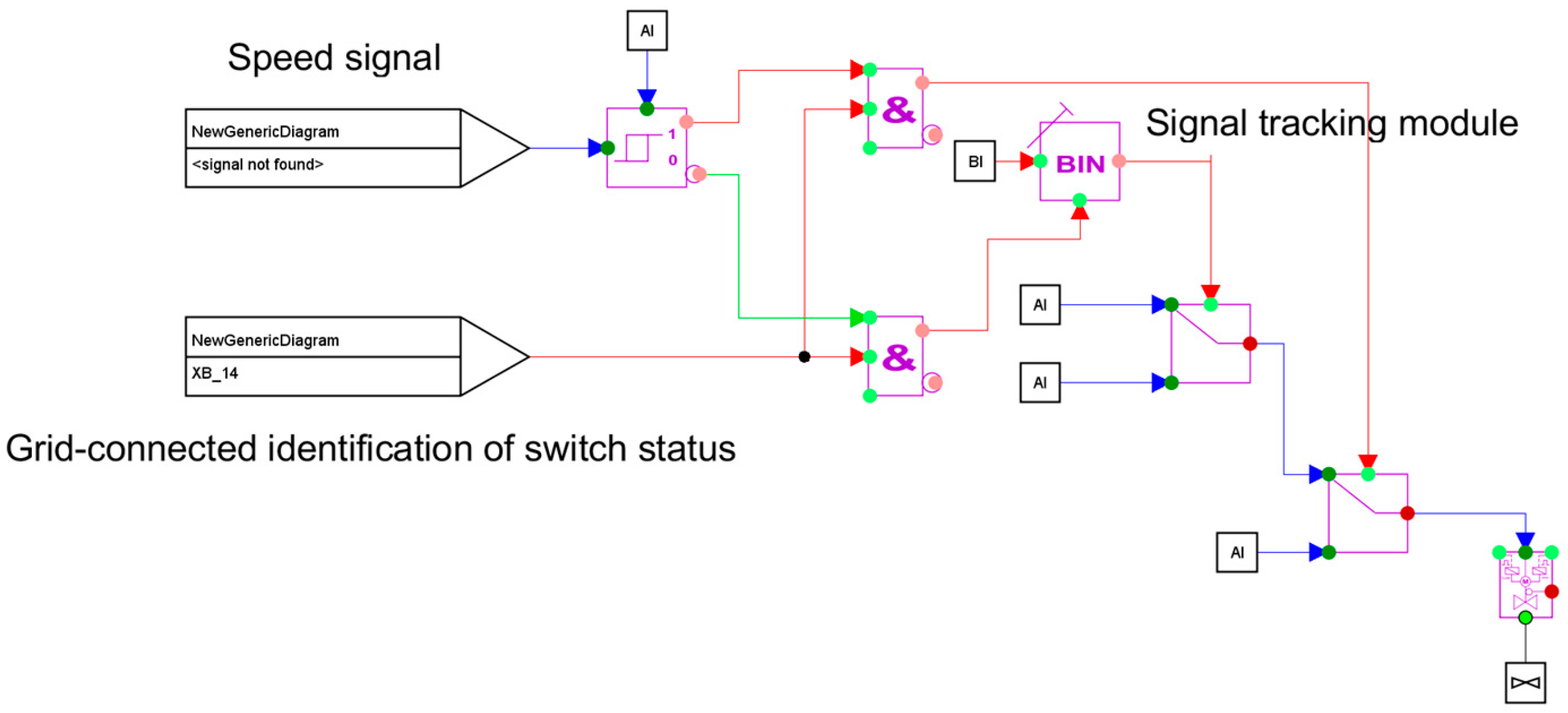
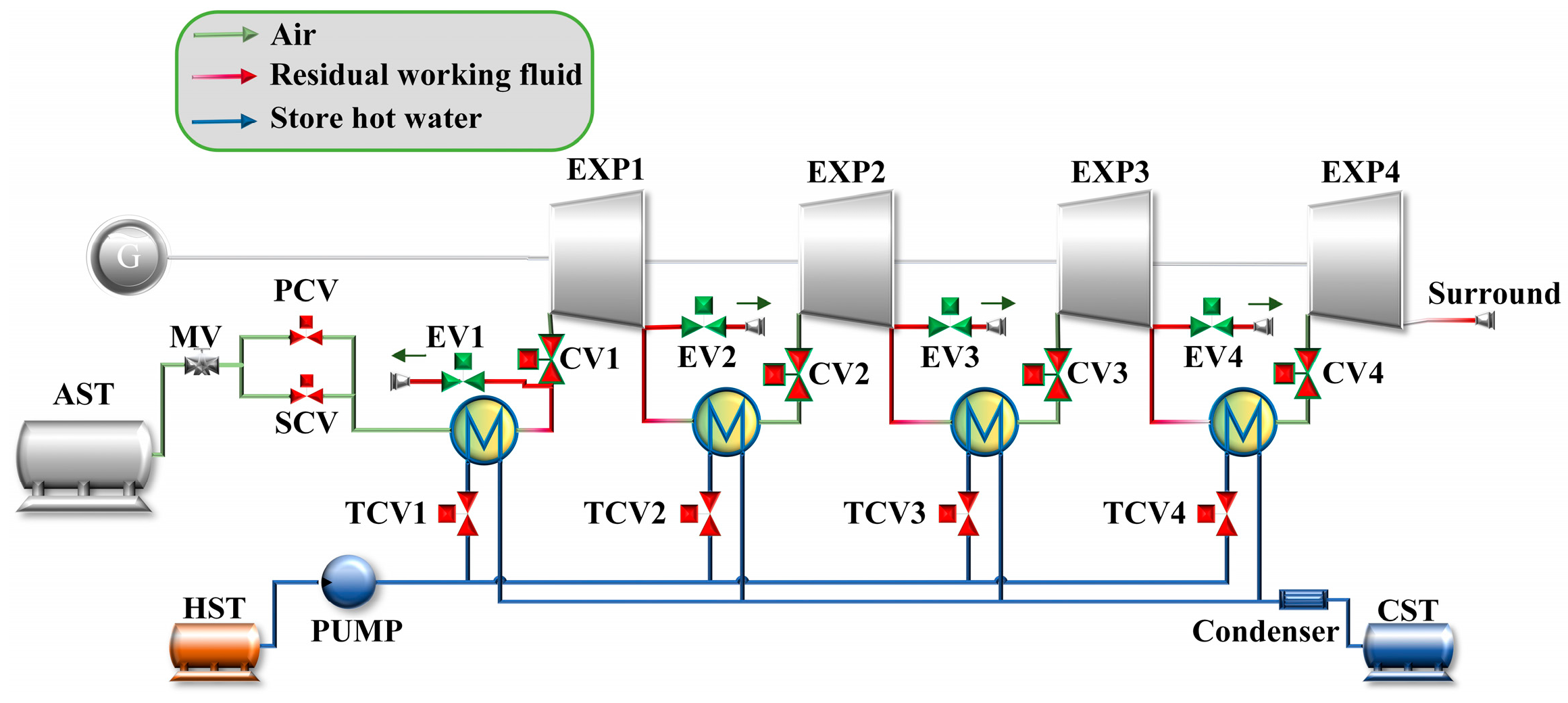

| Parameters | Unit | Value |
|---|---|---|
| Produce active power | MW | 10 |
| Energy release pressure | MPa | 7 |
| Energy storage pressure | MPa | 10 |
| Tank volume | m3 | 6000 |
| Back pressure | MPa | 0.1 |
| Ambient temperature | K | 298 |
| Energy Release Duration (10 MW) | s | 6550 |
| Heat storage tank temperature | K | 393 |
| Heat storage tank pressure | MPa | 20 |
| Cold storage tank Temperature | K | 298 |
| Cold Storage Tank Pressure | MPa | 0.1 |
| n | |||||||||
|---|---|---|---|---|---|---|---|---|---|
| Unit | bar | bar | °C | °C | % | kg/s | MW | r/min | |
| 1 | 69.92 | 25.25 | 84.64 | 44.51 | 2.7691 | 0.88 | 32 | 2.70884 | 3000 |
| 2 | 24.51 | 8.75 | 85.10 | 43.22 | 2.8011 | 0.88 | 32 | 2.67396 | 3000 |
| 3 | 8.57 | 3.12 | 85.02 | 42.86 | 2.7468 | 0.88 | 32 | 2.42832 | 3000 |
| 4 | 2.87 | 0.97 | 84.96 | 35.75 | 2.9588 | 0.88 | 32 | 2.45564 | 3000 |
| Progression | |||||
|---|---|---|---|---|---|
| 1 | 97.9 | 70.8 | 38.8 | 85.3 | 3.1416 |
| 2 | 99.9 | 71.4 | 35.6 | 85.8 | 3.1416 |
| 3 | 99.3 | 71.2 | 35.8 | 85.7 | 3.1416 |
| 4 | 99.4 | 69.8 | 28.4 | 85.2 | 3.1416 |
| Exp. No. | Action | Description |
|---|---|---|
| 1 |  | Do not close the cut-off valve |
| 2 |  | Close only the first-stage cut-off valve |
| 3 |  | Close primary and secondary cut-off valves |
| 4 |  | Close the primary and tertiary cut-off valves |
| 5 |  | Close the first and fourth stage cut-off valves |
| Exp. No. | Action | Description |
|---|---|---|
| 1 |  | Close only the fourth stage cut-off valve |
| 2 |  | Close the third and fourth stage cut-off valves |
| 3 |  | Close the second, third and fourth stage cut-off valves |
| 4 |  | Cut-off valve is fully closed |
Disclaimer/Publisher’s Note: The statements, opinions and data contained in all publications are solely those of the individual author(s) and contributor(s) and not of MDPI and/or the editor(s). MDPI and/or the editor(s) disclaim responsibility for any injury to people or property resulting from any ideas, methods, instructions or products referred to in the content. |
© 2025 by the authors. Licensee MDPI, Basel, Switzerland. This article is an open access article distributed under the terms and conditions of the Creative Commons Attribution (CC BY) license (https://creativecommons.org/licenses/by/4.0/).
Share and Cite
Wu, Y.; Wen, X.; Zhang, S.; Fan, Q.; Ye, H.; Wu, C. Optimization of Load Rejection Regulation for Compressed Air Energy Storage. Energies 2025, 18, 254. https://doi.org/10.3390/en18020254
Wu Y, Wen X, Zhang S, Fan Q, Ye H, Wu C. Optimization of Load Rejection Regulation for Compressed Air Energy Storage. Energies. 2025; 18(2):254. https://doi.org/10.3390/en18020254
Chicago/Turabian StyleWu, Yinghao, Xiankui Wen, Shihai Zhang, Qiang Fan, Huayang Ye, and Chao Wu. 2025. "Optimization of Load Rejection Regulation for Compressed Air Energy Storage" Energies 18, no. 2: 254. https://doi.org/10.3390/en18020254
APA StyleWu, Y., Wen, X., Zhang, S., Fan, Q., Ye, H., & Wu, C. (2025). Optimization of Load Rejection Regulation for Compressed Air Energy Storage. Energies, 18(2), 254. https://doi.org/10.3390/en18020254





